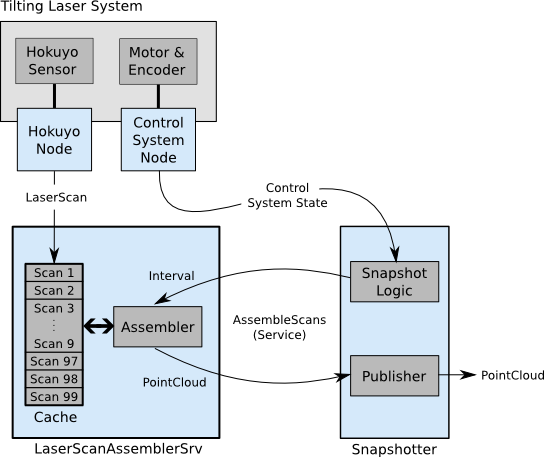Note that as of laser_pipeline-0.4.0 this API is deprecated. Please refer to the laser_assembler page for the latest API
Overview
The LaserAssembler package provides two ROS nodes:
laser_scan_assembler_srv: Assembles a stream of LaserScan messages into point clouds
point_cloud_assembler_srv: Assembles a stream of PointCloud messages into larger point clouds
The general data flow can be descibed as follows:

The LaserScanAssemblerSrv simply listens to the appropriate topic and accumulates messages in a ring buffer of a specific size. When the AssembleScans service is called, the scans in the requested interval are assembled into a single cloud and returned.
ROS Interface
Parameters:
The PointCloudAssemblerSrv and LaserScanAssemblerSrv share almost the exact same set of parameters
~tf_cache_time_secs (double) - The cache time (seconds) to hold past transforms
~tf_tolerance_secs (double) - The time (seconds) to wait after the transform for scan_in is available.
~max_scans (unsigned int) - The number of scans to store in the assembler's buffer
~fixed_frame (string) - A stationary frame to convert the scans to on reception
~ignore_laser_skew (bool) - For the laser_scan_assembler_srv only. Defaults to true. If true, pretend that all hits in a single scan correspond to the same tf transforms. If false, individually transform each hit to the fixed_frame (this is a fairly cpu intensive operation).
Services:
~build_cloud (laser_assembler/AssembleScans)
request: The time interval on which we want to aggregate scans
response: Assembled cloud for the requested interval
Input Topic:
~scan_in - Topic on which to receive a stream of scans (or clouds). The laser_scan_assembler_srv expects a stream of LaserScan messages, and the point_cloud_assembler_srv expects a stream of PointCloud messages
Interfacing with a Snapshotter
There are several robot systems (including the PR2) that have an articulated laser sensor. In these systems, it's often useful to get a "snapshot of the world". This can be done by writing a snapshotter.
The general data flow can be described as follows:

A snapshotter listens to the state of the mechanism, and then computes the interval on which to assemble scans. This interval is requested from LaserScanAssemblerSrv, and then published on a topic.
In the case of the pr2_laser_snapshotter, it listens to special messages from the control system that indicate when the tilting mechanism has reached the very top or bottom of its sweep.







